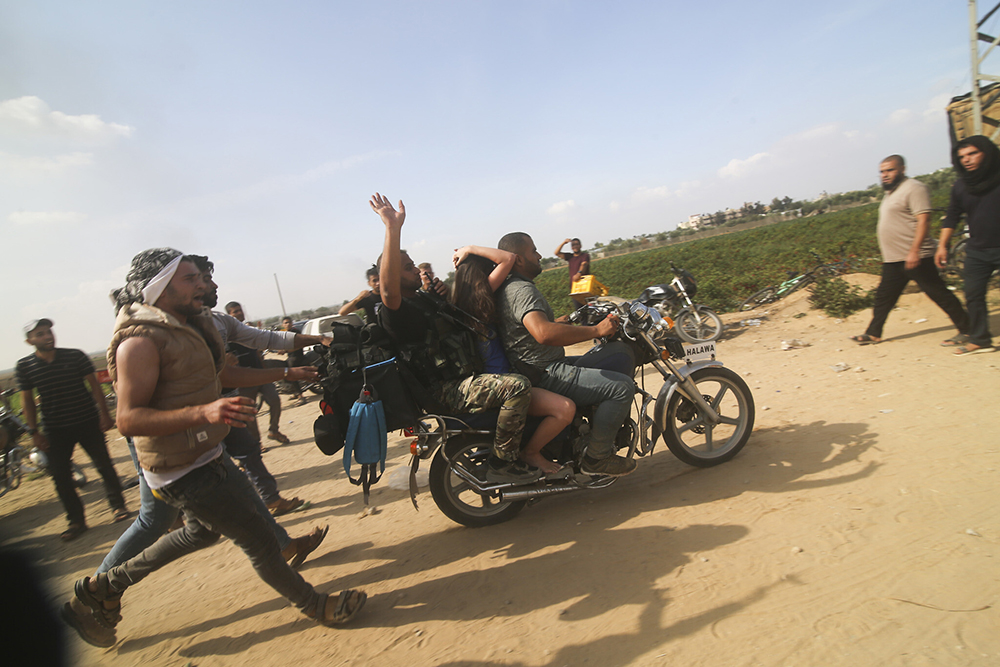|
Getting your Trinity Audio player ready...
|
Andrew Tobin
NIR OZ, Israel—Irit Lahav, a 58-year-old professional tour guide, knows how to walk clueless foreigners through unfamiliar terrain.
But in the year since she survived the Hamas-led Oct. 7 massacre in her kibbutz, Nir Oz, Lahav has struggled to explain to international media what happened that day. No matter how many interviews she arranges with her traumatized neighbors or tours she gives of their burned-out homes, many journalists have continued to tell the story of the worst attack on Jews since the Holocaust as another chapter in Israel’s supposed persecution of the Palestinians.
“People are saying Israel is bad,” Lahav, a former peace activist, told the Washington Free Beacon during a visit to Nir Oz last week. “What? The Palestinians are holding our hostages … How would one feel if it was their daughter, their grandfather, their father, their 2 -year-old children, baby Kfir [Bibas in Hamas captivity]?”
Nir Oz was one of the first Israeli communities to be overrun on Oct. 7, and it was among the hardest hit. Some 120 Hamas and Hamas-affiliated terrorists and 800 Palestinian “civilians,” including women and children, poured into the kibbutz, massacring 41 people and abducting 76 others, according to Lahav. Israel responded with an ongoing war to destroy Hamas and return the hostages.
A number of leading English-language news outlets have faced scrutiny for apparent anti-Israel bias in their coverage of the Gaza war and among staffers. The Washington Post has stood out from the crowd with repeated factual errors at Israel’s expense and a foreign desk packed with former employees of Al Jazeera, a Qatari network that the Jewish state recently banned from operating in the country, citing alleged ties to Hamas.
Lahav recalled with anger how the Canadian Broadcasting Corporation reported in August on the funeral of Avraham Munder, 79, who was abducted from Nir Oz on Oct. 7 along with his wife, daughter, and only grandson. The terrorists also killed Munder’s son during the attack. Munder “suffered bodily and mental torture for months” in Hamas captivity before he was killed, according to the Nir Oz community.
The CBC report, which aired on the state broadcaster’s flagship nightly news program, made no mention of the Oct. 7 attack or what happened to Munder or his family other than to question “whether it was Hamas or Israel’s attacks [on Hamas] that killed” him. The rest of the segment was dedicated to footage of displaced and injured Palestinians in Gaza, including many children.
“Some of their gruesome injuries, including small headless bodies, are just too horrendous to show,” the voiceover intoned.
Lahav accused the CBC of having “completely erased” Hamas’s atrocities in Nir On on Oct. 7.
“The Palestinians are very good at PR, they’ve done a very good job, and Israeli people say, ‘We don’t need to explain ourselves because we know that we are moral people,'” she added. “But at the end of the day, people only see what the media shows.”
Forty of the people who were abducted from Nir Oz were returned in a November ceasefire deal between Hamas and Israel, and another 16 have been confirmed dead. Twenty have remained in Gaza, potentially alive.
It is for the remaining hostages that Lahav keeps engaging the media.
“My friends who are there [in Gaza, like] Oded Lifshitz, who was like my second father, how would he feel if I would just be sitting around doing nothing?” she said. “I think they expect us, they expect the whole world to turn every stone and say, ‘No.’ They wait for us. They wait for us to rescue them, and ‘us’ is the whole world, the whole [of] humanity.”




